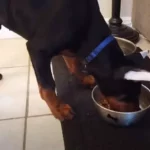If you have a female Doberman, you will know how much attention they get when they are on heat. The last thing we want is a pregnancy that wasn’t planned, especially if it wasn’t another Doberman she mated with.
There are some disputes with breeders as to the recommended age to get a Dobermans spayed; however, the consensus between vets is between four and nine months. You should get your spayed to stop them reaching sexual maturity. It is both uncomfortable and can take a lot of time and energy on your part.
Table of Contents
Should You Spay Your Doberman?
If you don’t want an unplanned pregnancy, you should spay your female Dobermans unless you plan to breed your dog.
If she ever gets out and comes across a male dog, the male dog (whether he is a Doberman or not) will likely try to mate with yours.
If another dog does try to mate, not only could this result in puppies that take a lot of time and money to care for, but it can be dangerous for both dogs.
You do not know what diseases the other dog might be carrying, and some mixed breeds come with their own health complications. Additionally, if you do not spay your dog, you will have to deal with regular heats.
How Old Is Too Old To Spay Your Dog?
There is not really a point in time that is too old to spay your dog. While most people get it done somewhere around six months, lots of people (especially breeders) end up getting their dogs spayed much later on.
On the other hand, any surgery (including being spayed) does have a higher risk for complication once your dog is older, but the risk is still relatively low with a routine spay surgery.
How Long Does It Take To Heal After Being Spayed?
Most incisions are fully healed between 10 and 14 days after the surgery takes place. Therefore, your vet will likely schedule the removal somewhere around this time frame if any stitches or staples need to be removed. Further, the worst discomfort or pain will only last a couple of days as long as there are no complications.
Possible Complications
- While there are lots of benefits to getting your dog spayed, there are a few potential complications that you need to be on the lookout for.
- Infection. An infection is one of the more common potential complications, and you should be checking the site of the incision about twice a day throughout the healing process to make sure that it is not infected. Signs of infection are the incision becoming super red, hot to the touch, or oozing blood and puss.
- Open incision. With most spay surgeries, the sutures are placed internally, which decreases the risk of them loosening or opening, but it is still possible. This is why you want to prevent your dog from licking or chewing the wound. You also want to avoid any rigorous exercise or hard playing
- Seromas. These are lumps or blisters that occur around the incision site. These bumps are often painless and clear up on their own, but if they start to ooze puss, you should take your dog to the vet because it may be an abscess. Abscesses can be painful and indicate infection.
- Hernia. Hernias are another kind of lump that can happen near the incision site. Many of them are just fat and will not cause your dog any pain at all. However, some are organs coming through the abdominal wall, which are much more serious. For this reason, you should always have your vet check out any hernias.
How Long Does It Take For A Dog’s Hormones To Balance?
Your dog’s sex hormones dissipate quickly after being spayed. Generally speaking, it takes about three weeks for them to balance out completely. However, she might still have a scent that attracts male dogs during this time, so that should not alarm you.
Does A Spayed Dog Still Have A Period?
When a Doberman gets spayed, its entire reproductive tract, including its ovaries and uterus, is removed. Therefore, as long as the surgery is a success, your dog should never go into heat again, which is one of the benefits of getting your dog spayed.
However, there is such a thing as Ovarian Remnant Syndrome. This syndrome is when some functioning ovarian tissue is left behind, resulting in a dog still experiencing heat.
Does A Spayed Dog Still Attract Males?

Female Dobermans who were spayed can still produce the hormone that attracts male dogs to mate. However, most desexed females produce this hormone so low that male dogs will not consider her a viable mate and, therefore, will not try to breed.
However, some females (especially during the first month after the surgery) produce enough of the hormone to attract males to breed.
Can A Spayed Dog Still Get Pregnant?
The surgery removes her entire reproductive tract, including her ovaries and uterus. Furthermore, the surgery is not reversible, so you will not be able to undo it and use your dog for breeding if you change your mind.
Can My Dog Pee After Being Spayed?
Yes, after your dog gets spayed, she should be able to pee just fine and without any pain. However, if your dog is not peeing, you may want to reach out to your vet. It could be a sign of a complication, or it could be due to reduced water intake. Any serious urinary blockages can be dangerous if not treated right away by a competent vet.
Leakage After Being Spayed
On the other hand, it is a more common problem for a dog to experience leakage or lose bladder control after being spayed.
Urinary incontinence happens in up to one out of five spayed female dogs, though it may not develop immediately.
You may not notice it until a few years later on. Sometimes this incontinence is temporary, but other times it is a more permanent problem that you and your dog will have to deal with.
The incontinence usually occurs due to a decrease in estrogen, which causes a urethral sphincter and the supporting tissue not to function as well.
There are some medications, such as Proin, that can help you treat this issue. However, these medications should only be used with the oversight of a trained vet because long-term use can result in some side effects.
Do Dobermans Calm Down After Being Spayed?
There can sometimes be behavioral changes when a female dog gets spayed. Some people say that their dogs become much more level and consistent after desexing, but these changes are not guaranteed.
Generally, you can expect that your dog’s behavioral development will stay pretty age-appropriate rather than shifting majorly after surgery.
Do Dogs Bark Less After Being Spayed?
For the first few days after your dog gets spayed, she might bark less than usual. This is likely due to a combination of discomfort and being on strong medications.
However, after your dog starts to heal, she will most likely go back to barking just as much as she did before.
What Happens If A Dog Jumps After Being Spayed?
As much as you can try to keep your dog from jumping or running after being spayed when she starts to feel better, it can be hard to accomplish.
However, until the stitches and incision site are completely healed, you want to try your best to keep your dog from jumping because it could open the wound and expose her internal organs.
If your dog runs or jumps, check the incision site as soon as possible to make sure everything is okay. If the wound is opened or loosened, take her to the vet immediately.
When Can I Let My Dog Run/Exercise After Being Spayed?
Generally speaking, after the last two weeks from the surgery, your dog can start exercising and playing more. Before this, you can take your dog out on a leash to go to the bathroom, but after two weeks, you can start to let your dog run and play like normal. If you still have concerns, you can always check with your vet to be sure.
How Do I Comfort My Dog After Being Spayed?
After your dog is spayed, you want to make sure she has a quiet, comfortable place to recover inside. In addition, you should make sure any other animals or small children are kept away from your dog.
You also may want to get a jumpsuit or cone to prevent your pet from licking or chewing the incision site. In the beginning, your dog will happily rest comfortably beside you, but later on, you may have to work harder to keep your dog from playing and exercising until the incision is completely healed.
Popular Posts
- 13 Things A Doberman Can Not Eat
 Dobermans are highly active dogs requiring a high-quality diet with a good fat to protein ratio. They eat more than less active dogs due to their energy levels. Adults eat 2 to 5 cups of dry food per day, while puppies from nine months to twelve months eat 4 to 7 cups per day.
Dobermans are highly active dogs requiring a high-quality diet with a good fat to protein ratio. They eat more than less active dogs due to their energy levels. Adults eat 2 to 5 cups of dry food per day, while puppies from nine months to twelve months eat 4 to 7 cups per day. - 5 Reasons Why Your Doberman is Leaking Urine?
 Dobermans leak urine for several reasons, but a urinary tract infection (UTI) is the most common. In addition, UTI and other urinary complications might be related to kidney disease, particularly with older dogs. Aside from UTIs, other issues such as arthritis, spinal and neurological problems can contribute to a leaky bladder.
Dobermans leak urine for several reasons, but a urinary tract infection (UTI) is the most common. In addition, UTI and other urinary complications might be related to kidney disease, particularly with older dogs. Aside from UTIs, other issues such as arthritis, spinal and neurological problems can contribute to a leaky bladder. - Are Dobermans Good For First Time Owners? 25 Things You Need To Know
 Dobermans are good for first-time owners. However, they are a big dog breed which means you will have to spend time training them to keep their behavior under control. For new owners, it could be good to work closely with an experienced trainer. But Dobermans are friendly, fun animals, making them a great option for even beginner dog owners.
Dobermans are good for first-time owners. However, they are a big dog breed which means you will have to spend time training them to keep their behavior under control. For new owners, it could be good to work closely with an experienced trainer. But Dobermans are friendly, fun animals, making them a great option for even beginner dog owners. - How Many Times Can A Doberman Give Birth? Myth Busted
 While a Doberman can continue to have litters as long as she is fertile (which does decrease with age), it is generally recommended that you only breed your female dogs three to four times. This means your Doberman should only be giving birth three to four times throughout her optimal breeding years.
While a Doberman can continue to have litters as long as she is fertile (which does decrease with age), it is generally recommended that you only breed your female dogs three to four times. This means your Doberman should only be giving birth three to four times throughout her optimal breeding years. - Why Do Dobermans Have Docked Tails? 5 Things You Should Know
 This article will talk about why you would want to dock your Dobermans tail, how long it takes to heal, and whether it is illegal here in the U.S.
This article will talk about why you would want to dock your Dobermans tail, how long it takes to heal, and whether it is illegal here in the U.S.
Table Of Content
- Should You Spay Your Doberman?
- Can My Dog Pee After Being Spayed?
- Can A Spayed Dog Still Get Pregnant?
- Do Dogs Bark Less After Being Spayed?
- Does A Spayed Dog Still Attract Males?
- How Old Is Too Old To Spay Your Dog?
- Does A Spayed Dog Still Have A Period?
- Do Dobermans Calm Down After Being Spayed?
- How Do I Comfort My Dog After Being Spayed?
- What Happens If A Dog Jumps After Being Spayed?
- How Long Does It Take To Heal After Being Spayed?
- How Long Does It Take For A Dog’s Hormones To Balance?
- When Can I Let My Dog Run/Exercise After Being Spayed?
